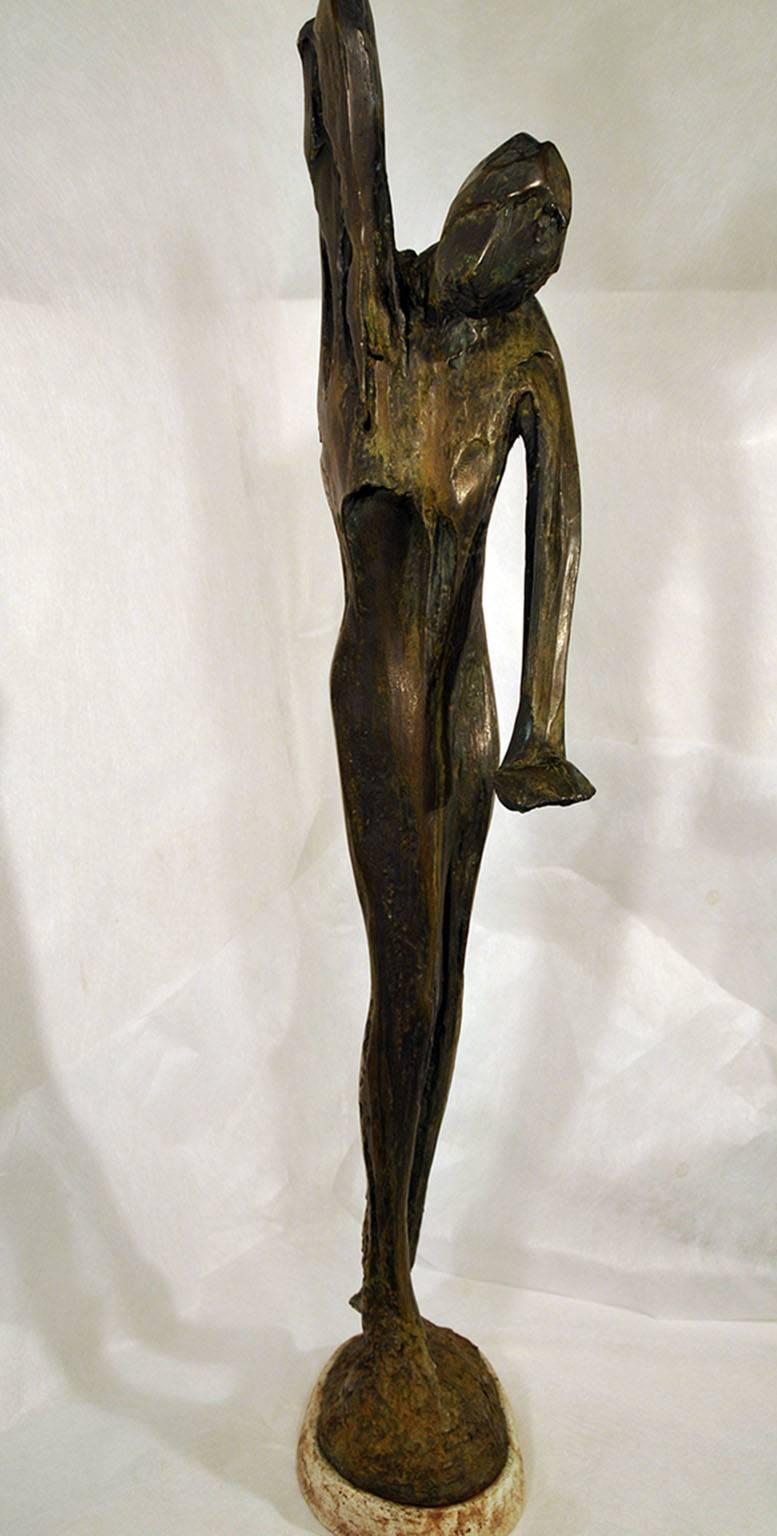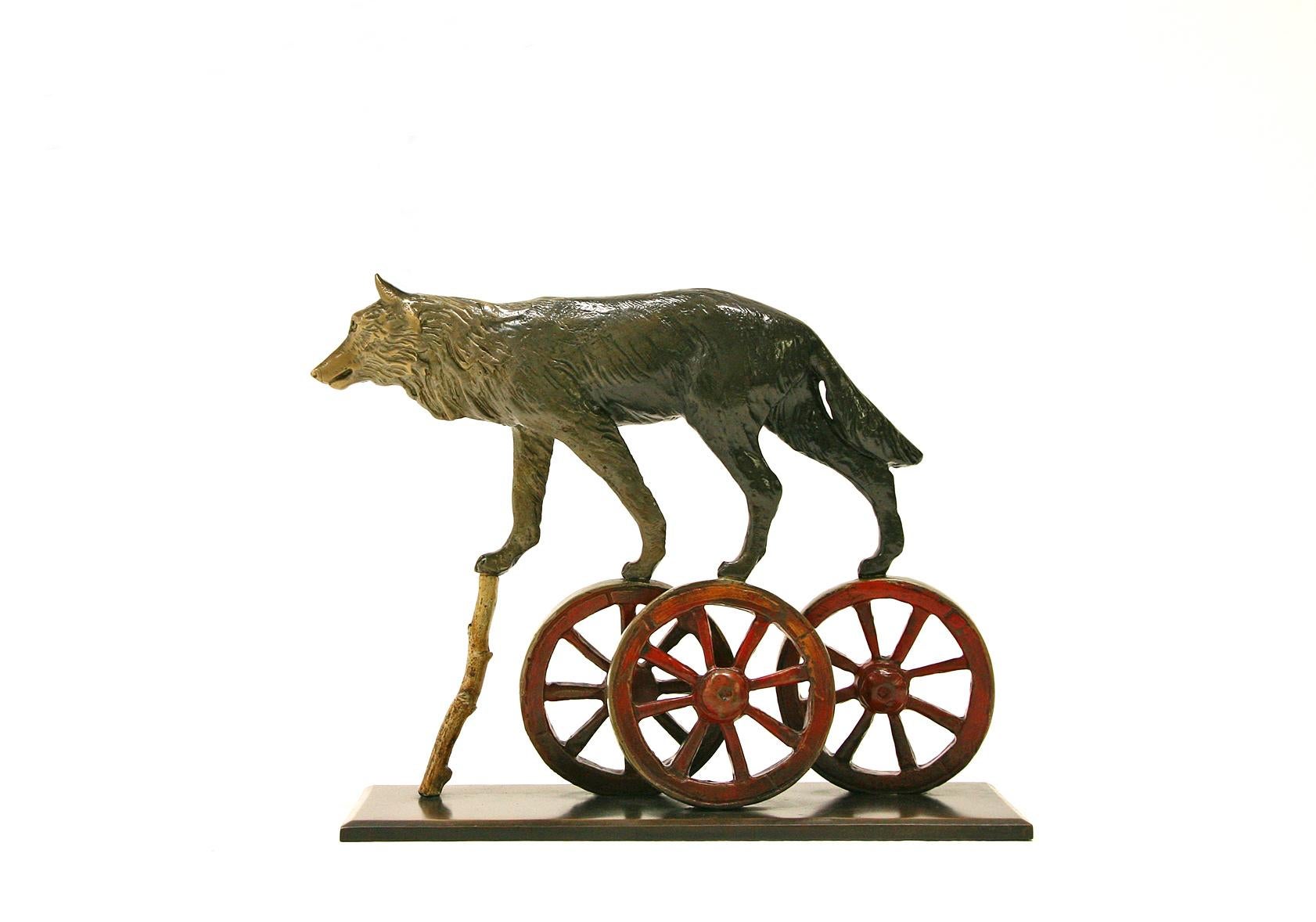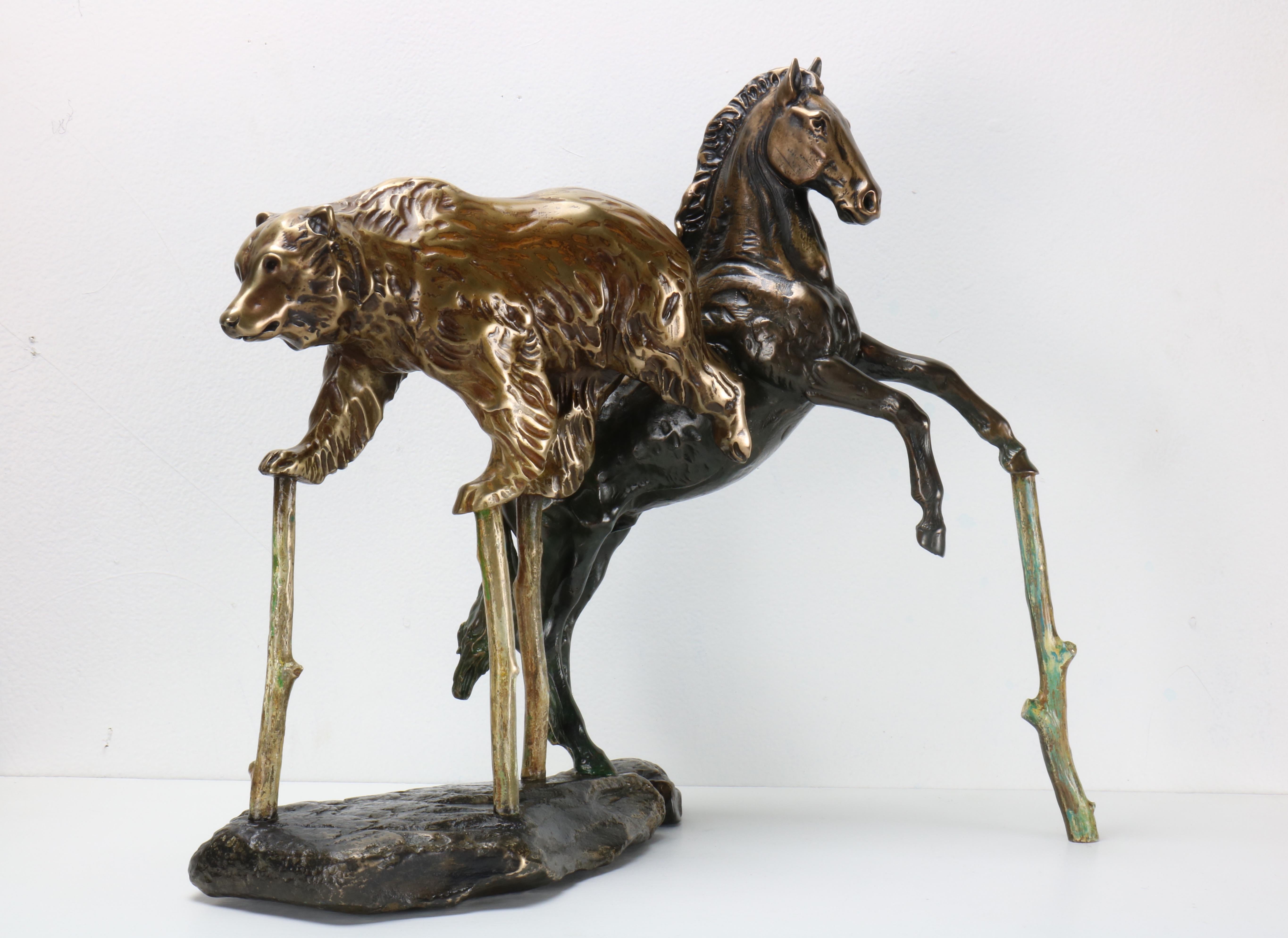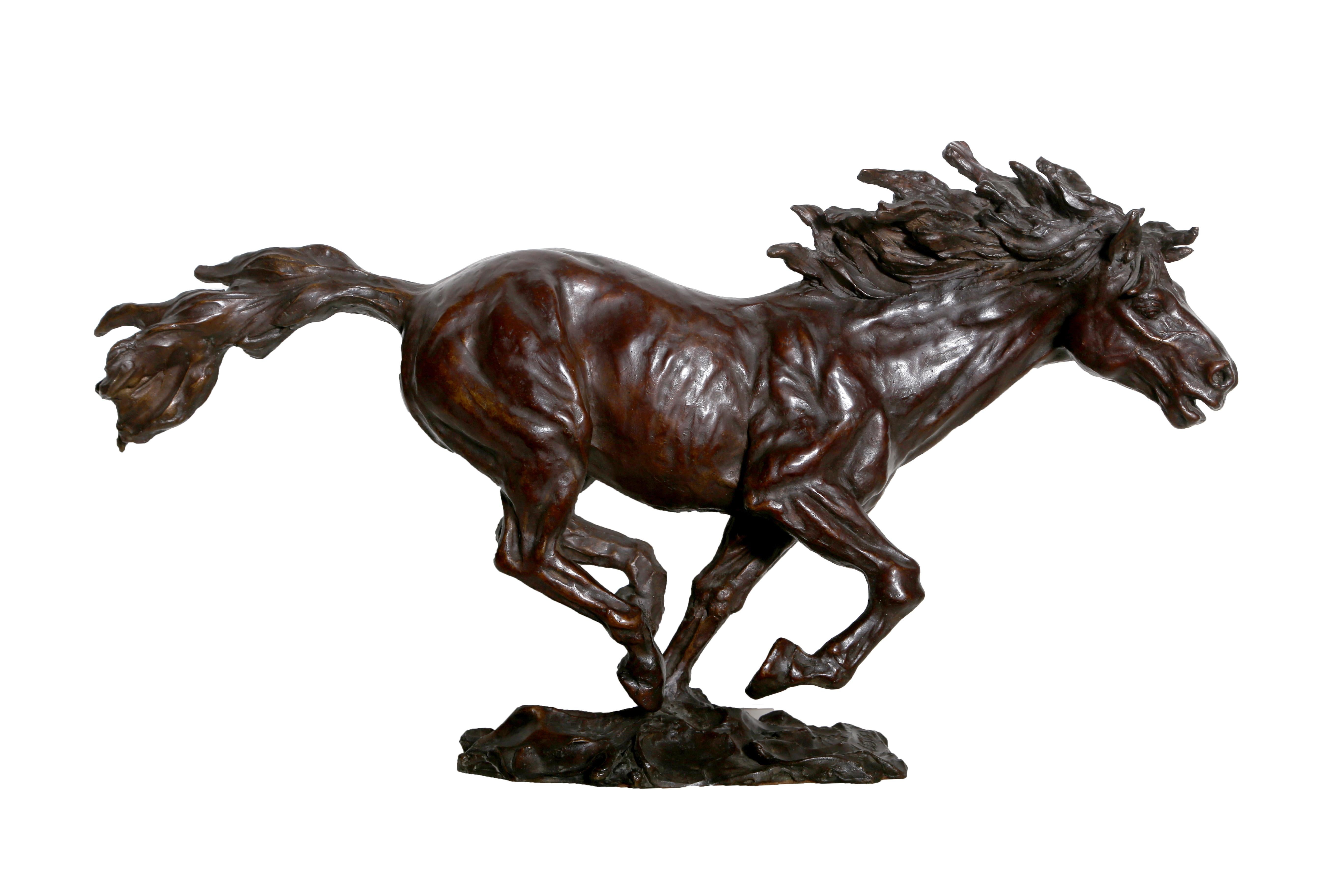Items Similar to Mongolian Dancer bronze sculpture by Malvina Hoffman
Want more images or videos?
Request additional images or videos from the seller
1 of 6
Malvina HoffmanMongolian Dancer bronze sculpture by Malvina Hoffman1932
1932
About the Item
Cellini Bronze Works, NY cast. Inscribed base edge. Edition unknown.
Malvina Hoffman conceived the Mongolian Dancer in 1932, as part of her Races of Mankind series commissioned by Stuart Field of the Chicago Field Museum of Natural History. In 1930, Hoffman was asked to create life sized sculptures of people from diverse cultures around the world. In her letters from the field, Hoffman told museum curators that she wanted to illustrate the dignity and individuality of each of her subjects. The collection, comprised of 105 sculptures, was housed in the Museum's "Hall of Man", it was also exhibited at the 1933 Chicago World's Fair and the 1938 New York World's Fair.
At the height of the collections popularity, several smaller limited edition castings of the sculptures were created. Two foundries are known to have cast the Mongolian Dancer: Roman Bronze Works in an edition of 18 and Cellini Bronze Works, quantity of edition unknown.
After 30 years on display, the "Hall of Man" exhibition was dismantled with the sculptures dispersed around the museum or placed into storage. Today nearly half of the sculptures from the original exhibition are once again on display in the Field Museum's new exhibition "Looking at Ourselves: Rethinking the Sculptures of Malvina Hoffman." This newer exhibition looks at both the nuance as well as the beauty which defines the people and inspiration of each sculpture.
- Creator:Malvina Hoffman (1887 - 1966, American)
- Creation Year:1932
- Dimensions:Height: 20.25 in (51.44 cm)Width: 15 in (38.1 cm)Depth: 6 in (15.24 cm)
- Medium:
- Movement & Style:
- Period:
- Condition:This piece is in very good condition, retaining its original untouched patina.
- Gallery Location:Hudson, NY
- Reference Number:1stDibs: LU2465212130012
About the Seller
5.0
Vetted Seller
These experienced sellers undergo a comprehensive evaluation by our team of in-house experts.
Established in 1973
1stDibs seller since 2023
6 sales on 1stDibs
Typical response time: 1 hour
- ShippingRetrieving quote...Ships From: Hudson, NY
- Return PolicyThis item cannot be returned.
More From This SellerView All
- Woman Reclined bronze sculpture by Yulla LipchitzLocated in Hudson, NYOrganic, abstract bronze sculpture by Yulla Lipchitz of a reclined woman. About this artist: Yulla Lipchitz, née Halberstadt, was born on April 21, 1911 in Berlin, Germany. While g...Category
1970s Modern Figurative Sculptures
MaterialsBronze
- Woman Lying Down & Growing with Tree bronze sculpture by Yulla LipchitzLocated in Hudson, NYOrganic, abstract bronze sculpture by Yulla Lipchitz of a woman lying down with a tree. About this artist: Yulla Lipchitz, née Halberstadt, was born on April 21, 1911 in Berlin, Ge...Category
1970s Modern Figurative Sculptures
MaterialsBronze
- Ancienne Noblesse wood sculpture by Irving LehmanLocated in Hudson, NYIrving Leeman's cubist inspired sculpture pays homage to artists such as Archipenko, Lipchitz, and Picasso. About this artist: Irving George Lehman was born in Kiev, Russia -now Uk...Category
Mid-20th Century Abstract Abstract Sculptures
MaterialsWood
- Leaping Marlin (with fisherman on the boat Islander) by John WhorfBy John WhorfLocated in Hudson, NYJohn Whorf captures one of the thrilling moments of fishing in this watercolor – when the fish is on the line, but still trying to escape. One of the fastest fish in the world, marlin fishing...Category
1950s American Modern Animal Drawings and Watercolors
MaterialsWatercolor, Paper
- St. Atomic oil and tempera painting by Julio de DiegoBy Julio de DiegoLocated in Hudson, NYJulio De Diego’s Atomic Series paintings made an extraordinary statement regarding the shock and fear that accompanied the dawn of the nuclear age. In the artist’s own words, “Scientists were working secretly to develop formidable powers taken from the mysterious depths of the earth - with the power to make the earth useless! Then, the EXPLOSION! . . . we entered the Atomic Age, and from there the neo-Atomic war begins. Explosions fell everywhere and man kept on fighting, discovering he could fight without flesh.” To execute these works, De Diego developed a technique of using tempera underpainting before applying layer upon layer of pigmented oil glazes. The result is paintings with surfaces which were described as “bonelike” in quality. The forms seem to float freely, creating a three-dimensional visual effect. In the 1954 book The Modern Renaissance in American Art, author Ralph Pearson summarizes the series as “a fantastic interpretation of a weighty theme. Perhaps it is well to let fantasy and irony appear to lighten the devastating impact. By inverse action, they may in fact increase its weight.” Exhibited 1950 University of Illinois at Urbana "Contemporary American Painting" 1964 Marion Koogler McNay Art Institute, San Antonio, Texas This work retains its original frame which measures 54" x 36" x 2". About this artist: Julio De Diego crafted a formidable persona within the artistic developments and political struggles of his time. The artist characterized his own work as “lyrical,” explaining, “through the years, the surrealists, the social-conscious painters and the others tried to adopt me, but I went my own way, good, bad or indifferent.” [1] His independence manifested early in life when de Diego left his parent’s home in Madrid, Spain, in adolescence following his father’s attempts to curtail his artistic aspirations. At the age of fifteen he held his first exhibition, set up within a gambling casino. He managed to acquire an apprenticeship in a studio producing scenery for Madrid’s operas, but moved from behind the curtains to the stage, trying his hand at acting and performing as an extra in the Ballet Russes’ Petrouchka with Nijinsky. He spent several years in the Spanish army, including a six-month stretch in the Rif War of 1920 in Northern Africa. His artistic career pushed ahead as he set off for Paris and became familiar with modernism’s forays into abstraction, surrealism, and cubism. The artist arrived in the U.S. in 1924 and settled in Chicago two years later. He established himself with a commission for the decoration of two chapels in St. Gregory’s Church. He also worked in fashion illustration, designed magazine covers and developed a popular laundry bag for the Hotel Sherman. De Diego began exhibiting through the Art Institute of Chicago in 1929, and participated in the annual Chicago Artists Exhibitions, Annual American Exhibitions, and International Water Color Exhibitions. He held a solo exhibition at the Art Institute of Chicago in the summer of 1935. Though the artist’s career was advancing, his family life had deteriorated. In 1932 his first marriage dissolved, and the couple’s young daughter Kiriki was sent to live with friend Paul Hoffman. De Diego continued to develop his artistic vocabulary with a growing interest in Mexican art. He traveled throughout the country acquainting himself with the works of muralists such as Carlos Merida, and also began a collection of small native artifacts...Category
1940s American Modern Abstract Paintings
MaterialsMasonite, Oil, Tempera
- Inevitable Day – Birth of the Atom oil and tempera painting by Julio De DiegoBy Julio de DiegoLocated in Hudson, NYJulio De Diego’s Atomic Series paintings made an extraordinary statement regarding the shock and fear that accompanied the dawn of the nuclear age. In the artist’s own words, “Scientists were working secretly to develop formidable powers taken from the mysterious depths of the earth - with the power to make the earth useless! Then, the EXPLOSION! . . . we entered the Atomic Age, and from there the neo-Atomic war begins. Explosions fell everywhere and man kept on fighting, discovering he could fight without flesh.” To execute these works, De Diego developed a technique of using tempera underpainting before applying layer upon layer of pigmented oil glazes. The result is paintings with surfaces which were described as “bonelike” in quality. The forms seem to float freely, creating a three-dimensional visual effect. In the 1954 book The Modern Renaissance in American Art, author Ralph Pearson summarizes the series as “a fantastic interpretation of a weighty theme. Perhaps it is well to let fantasy and irony appear to lighten the devastating impact. By inverse action, they may in fact increase its weight.” Bibliography Art in America, April 1951, p.78 About this artists: Julio De Diego crafted a formidable persona within the artistic developments and political struggles of his time. The artist characterized his own work as “lyrical,” explaining, “through the years, the surrealists, the social-conscious painters and the others tried to adopt me, but I went my own way, good, bad or indifferent.” [1] His independence manifested early in life when de Diego left his parent’s home in Madrid, Spain, in adolescence following his father’s attempts to curtail his artistic aspirations. At the age of fifteen he held his first exhibition, set up within a gambling casino. He managed to acquire an apprenticeship in a studio producing scenery for Madrid’s operas, but moved from behind the curtains to the stage, trying his hand at acting and performing as an extra in the Ballet Russes’ Petrouchka with Nijinsky. He spent several years in the Spanish army, including a six-month stretch in the Rif War of 1920 in Northern Africa. His artistic career pushed ahead as he set off for Paris and became familiar with modernism’s forays into abstraction, surrealism, and cubism. The artist arrived in the U.S. in 1924 and settled in Chicago two years later. He established himself with a commission for the decoration of two chapels in St. Gregory’s Church. He also worked in fashion illustration, designed magazine covers and developed a popular laundry bag for the Hotel Sherman. De Diego began exhibiting through the Art Institute of Chicago in 1929, and participated in the annual Chicago Artists Exhibitions, Annual American Exhibitions, and International Water Color Exhibitions. He held a solo exhibition at the Art Institute of Chicago in the summer of 1935. Though the artist’s career was advancing, his family life had deteriorated. In 1932 his first marriage dissolved, and the couple’s young daughter Kiriki was sent to live with friend Paul Hoffman. De Diego continued to develop his artistic vocabulary with a growing interest in Mexican art. He traveled throughout the country acquainting himself with the works of muralists such as Carlos Merida, and also began a collection of small native artifacts...Category
1940s American Modern Abstract Paintings
MaterialsMasonite, Oil, Tempera
You May Also Like
- UpBy Robert CookLocated in New York, NYBronze, 1967. Height 59" (149.9 cm) width max 15" (38 cm). Signed on base "R Cook." This unique large sculpture was made using the lost wax process. “ . . . Inspired by a da...Category
Mid-20th Century American Modern Figurative Sculptures
MaterialsStone, Bronze
- Show of InterestBy Brad RudeLocated in Denver, COArtist Brad Rude was born in Montana and has lived in Walla Walla, Washington most of his life. His journeys through his grandfather's folk art studio left...Category
2010s American Modern Figurative Sculptures
MaterialsEnamel, Bronze
- RenegadeBy Brad RudeLocated in Denver, COEd. 3/6 Artist Brad Rude was born in Montana and has lived in Walla Walla, Washington most of his life. His journeys through his grandfather's folk art st...Category
2010s American Modern Figurative Sculptures
MaterialsEnamel, Bronze
- Combined EffortBy Brad RudeLocated in Denver, COArtist Brad Rude was born in Montana and has lived in Walla Walla, Washington most of his life. His journeys through his grandfather's folk art studio left...Category
2010s American Modern Figurative Sculptures
MaterialsEnamel, Bronze
- Mustang, Bronze Sculpture by Arnold GoldsteinLocated in Long Island City, NYBronze sculpture of a wild mustang horse created by American artist Arnold Goldstein. This artwork has the signature and numbering inscribed. Numbered...Category
1970s American Modern Figurative Sculptures
MaterialsBronze
- Evening Paper, Modern sculpture by Bruno LucchesiBy Bruno LucchesiLocated in Long Island City, NYA Modern figurative sculpture by Bruno Lucchesi of a man reading his even paper with fascination. Evening Paper Bruno Lucchesi, Italian (1926) Date: 1961 Bronze Sculpture, signed Si...Category
1960s American Modern Figurative Sculptures
MaterialsBronze
Recently Viewed
View AllMore Ways To Browse
Antique Sculpture
Antique Sculptures
Antique Sculpture Art Sculptures
Antique Figurative Sculptures
Antique Bronze Sculpture Art Sculptures
Sculpture Display Base
Antique Dance
Small Antique Sculpture
Antique Cast Bronze Sculpture
Roman Bronze
Bronze Dancer
Dance Bronze
Dancing Bronze
Figurative Dancer Sculpture
Antique Roman Bronze
Antique American Sculpture
Bronze Dance Sculpture
Bronze Sculpture Dancers




